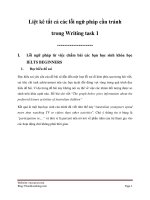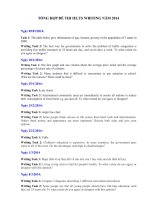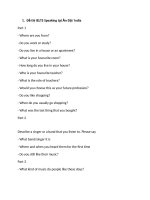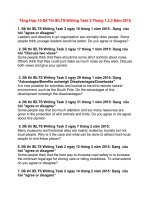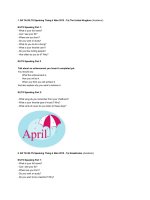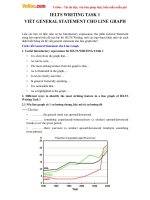TỔNG hợp đề LUYỆN IELTS WRITING TASK 1 THEO DẠNG
Bạn đang xem bản rút gọn của tài liệu. Xem và tải ngay bản đầy đủ của tài liệu tại đây (2.01 MB, 265 trang )
IELTS WRITING TASK 1
THEO DẠNG ĐỀ
1.
2.
3.
4.
5.
1.
Bar chart
Line chart
Pie chart
Table
Describing process VÀ MIX
BAR CHART
Test Tip
When writing a Task 1 answer, it is important to describe numbers and
data in different ways to avoid repetition. You will be given credit for doing
this, as it will show you have a wider range of vocabulary.
ĐỀ BÀI VÀ BÀI MẪU
You should spend about 20 minutes on this task.
The chart below gives information about Someland's main exports in 2005,
2015,
and
future
projections
for
2025.
Summarise the information by selecting and reporting the main features,
and make comparisons where relevant.
Write at least 150 words.
Model answer
This bar chart illustrates the performance of Someland's primary exports in
2005 and 2015. It also indicates future projections for 2025. According to
the data, it seems likely that international tourism will become the
dominant industry, although dairy exports will remain strong. In 2005, we
can see that tourism was the greatest exports earner of the three industries,
with revenue standing at just over $6 billion.
This figure has increased slightly, so that now, in 2015, it has reached
almost $7 billion. It is estimated that international tourism will continue to
grow, so that by 2025, it will be earning around $8 billion for the country.
In 2000, dairy exports were worth around $5 billion, but since then there
has been a dramatic increase, and sales for this year are approximately $8
billion. Experts are predicting that exports in this area may fall slightly, so a
figure of $7.5 billion is expected for 2025. Meat products are the third key
industry in Someland, but sales have dropped since 2000 and now stand at
$3.5 billion. It is expected that sales will continue to decrease in the future.
(187 words)
Writing Exam Tip
You do not have to write very long sentences to do well in your Writing test.
If sentences are too long, they will become less coherent and also make it
harder for you to control the grammar.
You should spend about 20 minutes on this task.
The chart below shows the number of travellers using three major airports
in
New
York
City
between
1995
and
2000.
Summarise the information by selecting and reporting the main features,
and make comparisons where relevant.
Write at least 150 words.
Model answer
The bar chart gives information about how many people visited New York
City through three major airports, over a six-year period between 1995 and
2000.
Overall, it can be seen that over the period, there was a fluctuant trend in
the number of passengers who travelled via John F. Kennedy airport, while
the other two airports saw an upward trend. Another interesting point is
that LaGuardia airport was the most popular at the end.
Looking at the detail, the number of travellers at John F. Kennedy airport
started at 26m in 1995, and then increased remarkably to reach the highest
point of 47m in 1997. In 1999, the figure dipped to 32m. At the last year,
there was a slight growth to 44m. On the other hand, LaGuardia began at
35m in 1995, after that it rose remarkably for the next three years, at 46m.
In 2000, LaGuardia hit the peak point at 68m travellers.
However, if we look at Newark airport, it started at the lowest point of 16m
passengers in the first year. After this point, the trend increased
significantly to 42m in 1998. In the last two years it remained stable at 42m
travellers.
(197 words)
You should spend about 20 minutes on this task.
The bar chart below shows shares of expenditures for five major categories
in the United States, Canada, the United Kingdom, and Japan in the year
2009.
Write a report for a university lecturer describing the information below.
Write at least 150 words.
Source: U.S. Bureau of Labor Statistics
Test Tip
In Writing Task 1, it is a good idea to end your answer by summarizing the
main information shown by the diagram. You are not required to explain
this information.
Read the following sample answer. Complete the answer by filling
the gaps with the words in the box.
by contrast
Indicates
Lowest
compares
overall
Whereas
Except
higher
highest
However
Largest
among
The bar chart ........... how consumers in the United States, Canada, the
United Kingdom, and Japan allocated different shares of total spending to
categories such as food, housing, and transportation in 2009.
We can see that the United States had the ........... housing expenditure share,
26% of total expenditures in 2009. The United Kingdom and Japan
followed, with 24% and 22%, respectively. Canada had the ........... housing
share at 21%. Housing was the ........... expenditure component in all
countries ........... Japan.
..........., Canada had the largest transportation share of all four countries at
20%. The United States and the United Kingdom had the next-highest
transportation shares, 17% and 15%, respectively. Japan had the lowest, at
10%.
..........., in Japan, consumers spent 23% of their total expenditures on food in
2009. The United Kingdom had the second-highest share at 20%. Canada,
with 15%, and the United States, with 14% had the lowest food expenditure
shares
among
the
countries
studied.
..........., the data ........... that housing and health care shares of total
expenditures were ........... in the United States than in Canada, the United
Kingdom, and Japan in 2009, ........... Americans had the lowest clothing
share. Canada had the highest clothing and transportation shares, and
Japan had the highest food share, ........... the countries compared.
(214 words)
Test Tip
You only have 20 minutes to do Writing Task 1, so make sure the points you
include
are:
Relevant – you will waste time and lose marks if you don’t follow the
instructions.
Don’t
speculate
or
add
your
own
opinions.
Not repetitive – don’t say the same thing in different words, or write similar
sentences about all the figures. Describe something different in every point.
Make comparisons and describe trends rather than focus on individual
numbers.
Accurate – giving the wrong information loses marks, so study the question
carefully and interpret data or diagrams correctly.
You should spend about 20 minutes on this task.
The chart below shows the percentage of male and female teachers in six
different
types
of
educational
setting
in
the
UK
in
2010.
Summarise the information by selecting and reporting the main features,
and make comparisons where relevant.
Write at least 150 words.
Model answer
The bar chart gives information about the gender of teachers in six types of
educational institutions in the UK in 2010. It shows what percentage of
teachers
was
male
and
what
percentage
was
female.
Women dominated the teaching profession in primary education, but less so
at lower and upper secondary education. It was particularly true of nursery
school, where the share of female teachers was above 95%. Similarly onesided was the situation in primary school, where over 90% of teachers were
also
female.
At secondary and upper secondary level this pattern was less pronounced,
where there were nearly equal proportions of male and female teachers. On
the other hand, male teachers outnumbered female teachers in high-level
education, where the proportion of men was twice that for women.
Overall, the higher the level of education, the more male teachers
dominated, and the reverse occurred with respect to female teachers.
(150 words)
You should spend about 20 minutes on this task.
The chart below shows the percentage change in the share of international
students among university graduates in different Canadian provinces
between
2001
and
2006.
Summarise the information by selecting and reporting the main features,
and make comparisons where relevant.
Write at least 150 words.
Source: Statistics Canada, Postsecondary Student Information System
Test Tip
In Task 1 of the IELTS Writing modules, you may be asked to describe a
graph which shows changes over a period of time. To do this you need to
use language expressing change and appropriate tenses. In the exam, make
sure you leave time to edit your written answer. You will lose marks if you
make too many mistakes in grammar and vocabulary.
Model answer
The chart shows changes in the share of international students who
graduated from universities in different Canadian provinces over a period
of
5
years.
In 2001, this share had a relatively narrow range, from 3% in Ontario to
7.0% in New Brunswick. Nova Scotia had the second highest proportion at
6.5%. Five years later, the figures for most provinces had risen, with the
exception of Alberta. There, the figures fell by 1% to just over 4%.
By 2006, some parts of Canada experienced a considerable increase in their
share of international graduates. Growth in this share was especially strong
in the case of New Brunswick, where the figures rose from 7% to 12%. The
largest growth occurred in British Columbia, where it more than doubled to
11%.
Over this five-year period, changes in the proportion of international
graduates have been very uneven across the provinces of Canada. However,
New Brunswick remained the province with the highest percentage overall.
(158 words)
Test Tip
This chart does not provide information about population size. If you
choose to include information in your answer that is not given in the task,
you will not get extra marks. In fact, it may be considered irrelevant and
you may be penalised if you make detailed comments about information
that is not provided in the chart.
You should spend about 20 minutes on this task.
The chart below gives information about the most common sports played in
New
Zealand
in
2002.
Summarise the information by selecting and reporting the main features,
and make comparisons where relevant.
Write at least 150 words.
Model answer
The bar graph provides information about the most Common sports played
in New Zealand in 2002. It gives figures for both boys and girls and clearly
shows that their participation in sports is fairly equal. However, their
sporting preferences tend to be different.
According to the graph, the most popular sport among girls is netball, with
participation rates reaching 25 per cent. A similar percentage of boys
prefer soccer, which is clearly their favourite sport. Ten per cent of boys also
enjoy playing cricket but hardly any girls take part in this game. While
swimming is popular among both boys and girls, fewer boys participate in
this sport - about 13 per cent compared to approximately 22 per cent of
girls.
Other sports such as tennis, basketball and martial arts have lower levels of
popularity, and a significant percentage of boys and girls say they enjoy
sports not referred to on the chart.
(153 words)
IELTS Tip
1) Focus on the most important aspects of any data you are given. Do not
quote the data mechanically. Link your ideas together naturally while
referring
to
specific
data.
2) Think about the most significant changes over time or the key points of
comparison
between
different
categories.
3) Organise your description of the data around these key points, and
include any relevant secondary points.
You should spend about 20 minutes on this task.
The bar chart below shows the percentage of students who passed their
high school competency exams, by subject and gender, during the period
2010-2011.
Summarise the information by selecting and reporting the main features,
and make comparisons where relevant.
Write at least 150 words.
Students passing high school competency exams, by subject and gender,
2010-2011
*includes French, German and Spanish
Look at the graph and complete the following model answer by
writing NO MORE THAN THREE WORDS in each space.
Model answer
The graph shows the percentages of boys and girls who were successful in
their high school competency exams in the period from 2010 to 2011, by
subject.
Overall, students of both sexes .......... best in Computer Science, Mathematics,
and Foreign Languages, .......... French, German and Spanish. Results for boys
and girls were roughly .......... in Computer Science and Mathematics. In
other subjects, .........., there were some significant ...........
Girls achieved by far their .......... in Computer Science, with a pass rate
of .........., which was ..........than the boys. The difference was even .......... in
Chemistry, where .......... more girls passed. ..........subject where boys’ results
were better than girls was .......... where they achieved a pass rate of..........,
which was 10% higher than .......... for girls.
In general, .......... that during the period in question girls performed better in
most subjects in the competency exams than boys.
Writing Exam Tip
When you first see a bar chart, ask yourself the following questions:
1) What do the numbers on the vertical/horizontal axis measures?
2)
How
3)
What
4)
is
the
do
When
the
information
different
was
grouped
shades
the
on
of
the
the
data
other
bars
axis?
show?
collected?
The answers will give you the essential information for understanding it.
Make sure you know which units are being used to measure quantities.
You should spend about 20 minutes on this task.
The chart below gives information about the UK's ageing population in
1985
and
makes
predictions
for
2035.
Summarise the information by selecting and reporting the main features,
and make comparisons where relevant.
Write at least 150 words.
Source: Office for National Statistics, National Records of Scotland,
Northern Ireland Statistics and Research Agency
Exam Tip
In Writing Task 1, it is essential to understand what the graph or chart is
representing. Look closely at the information in the instructions as well as
all
details
of
the
graph
or
chart.
The graph in this task shows the percentage of over 65s in each country of
the UK. The following are incorrect statements:
•
Wales had more over 65s than England. (The graph is in percentages,
not numbers)
•
Northern Ireland had 12% of over 65s in 1985. (The countries do not
add up to 100% so Northern Ireland did not have 12% of all over 65s. The
graph shows that 12% of thepopulation of Northern Ireland was over 65.)
Model answer
The graph shows how the size and distribution of the UK's ageing
population
is
likely
to
change
over
a
50-year
period.
Overall, the proportions are predicted to increase in all UK countries. In
1985, 15 per cent of the UK population was over 65, but by 2035, this will
account
for
23
per
cent
of
the
total
population.
A closer look at the data reveals that the ageing population is expected to
rise more in some parts of the UK than in other. In 1985, Wales had the
highest percentage of people aged 65 and over, at 16 per cent. The secondlargest group could be found in England and the third in Scotland.
Northern Ireland had lowest proportion, with 12 per cent aged 65 and over.
By 2035, Wales is still going to have by far the greatest percentage of over
65s, with figures likely to reach 26 per cent. However, the biggest increases
in this age group, relative to the rest of the population, are predicted to
occur in Northern Ireland and Scotland. In Northern Ireland, for example,
this figure will increase almost double to 23 per cent.
(189 words)
You should spend about 20 minutes on this task.
The chart below shows the total number of minutes (in millions) of
telephone calls in Finland, divided into three categories, from 1995 – 2004.
Summarise the information by selecting and reporting the main features,
and make comparisons where relevant.
Write at least 150 words.
Model answer
The chart shows the time spent by Finland’s residents on different types of
telephone
calls
between
1995
and
2004.
Local landline calls were the highest throughout the period, rising from
12000 million minutes in 1995 to just under 17000 million in 2000. After
peaking at 17000 million the following year, these calls had fallen back to
the
1995
figure
by
2004.
National and international landline calls grew steadily from 6000 million
to 10500 million at the end of the period in question, though the growth
slowed
over
the
last
two
years.
There was a dramatic increase in mobile calls from 250 to 9800 million
minutes. This rise was particularly noticeable between 2000 and 2004,
during
which
time
the
use
of
mobile
phones
tripled.
To sum up, although local landline calls were still the most popular in 2004,
the gap between the three categories had narrowed considerately over the
second half of the period in question.
(155 words)
You should spend about 20 minutes on this task.
The chart below gives information about science qualifications held by
people
in
two
countries.
Summarise the information by selecting and reporting the main features,
and make comparisons where relevant.
Write at least 150 words.
Model answer
The bar chart illustrates the percentage of people who hold a science
qualification in Singapore and Malaysia. A prominent feature is that a
significantly low percentage of people hold science qualifications, that is
Master’s and Bachelor’s degrees in science from university level studies in
both countries. Less than 5% of people hold a qualification in science at
Master’s degree level in both Singapore and Malaysia.
There is a significant difference in the percentage of people holding science
qualifications at Bachelor level between the two countries; while this
number is 20% in Singapore, in Malaysia it is a mere 10%. The percentage
of people with school leaving exams in science is slightly higher in Malaysia
than in Singapore. 35% of people in Malaysia have a science qualification
at this level, whereas the number in Singapore is 5% lower. Finally, more
than half the people in both countries hold no science qualification at all.
(152 words)
English grammar tips
The following is a brief summary of the main tenses that you need to be
aware of in preparing for IELTS:
•
We use the present simple tense to describe tables and diagrams: As
the graph indicates… The X then passes to the next stage… (Writing)
•
We use the present progressive tense to describe change and
development: The population is decreasing rapidly. (Writing)
•
We use the present perfect simple tense to talk about past events
which are still valid:Experiments have shown that… (Writing)
•
We use the past simple tense to mention past experience to support
an argument: I had one teacher in particular who inspired me.
(Speaking/Writing)
•
We use the past perfect simple tense to describe graphs: By the year
X, the price of Y had fallen. (Writing)
•
We use the future simple tense to talk about the future: I hope I’ll
pass the exam. (Speaking)
You should spend about 20 minutes on this task.
The bar chart below gives information about the number of students
studying Computer Science at a UK university between 2010 and 2012.
Summarise the information by selecting and reporting the main features,
and make comparisons where relevant.
Write at least 150 words.
Model answer
The bar chart illustrates the number of male and female students studying
Computer Science at a UK university over three years. It also indicates
whether they were home or international students. Compared to the
number of home students, the number of international students was
significantly smaller. Nevertheless, there was clear statistical growth in the
latter group from 2010-2012. Furthermore, the number of female home
students eventually overtook the number of males from the same group,
reaching
a
high
of
45
in
2012.
The year 2011 saw the most dramatic developments; the number of male
home students fell from just below 40 to 24 and the number of females rose
from 32 to 44. There was also significant growth in the number of male
students from overseas, climbing from 20 in 2010 to 39 in 2012. Overall, we
can see an upward trend in the number of students at the university.
(150 words)
describing visual information in Task 1, it is important to think about what
tenses you will need. If the diagram includes time references (dates, years)
you will need a range of pastand present tenses. If the graph has no past
time reference, you will need to use the present simple tense only.
You should spend about 20 minutes on this task.
You should spend about 20 minutes on this task.
The table below gives information about Favorite Pastimes in different
countries.
Summarise the information by selecting and reporting the main features,
and make comparisons where relevant.
Write at least 150 words.
From 30 - 50 years old
TV
Sport
Reading Hobbies Music Beach Sleep
Canada
60
22
15
40
3
0
2
France
/
/
30
20
4
/
/
England /
/
30
21
4
/
20
Australia 65
30
15
45
5
30
4
Korea
22
21
60
45
2
2
4
China
15
25
60
50
0
5
5
USA
60
23
15
42
23
30
2
Japan
/
/
62
/
/
/
/
Model answer
This table clearly presents and compares favorable pastimes in eight
different countries. The pastimes, across the top of the table, are analyzed
in
relation
to
each
country.
As can be seen, about 60% of Canadians, Australians and Americans like
watching television. On the other hand, this figure is quite low for China
where only 15% of people watch television. Predictably, Americans like
music at 23%, whereas only 2 to 5% of people in the other countries feel the
same way. 20% of people in England enjoy sleeping as a pastime whereas in
Canada and the USA, for example, the figure is only 2%. Interestingly, the
Chinese like hobbies the most at 50%, as opposed to only 20% in France. It
isn’t surprising that the highest percentage of beach-lovers is in Australia
and
the
USA
at
30%.
It seems that pastimes of people of different nationalities may be influenced
by a number of factors such as the socio-economic situation or the climate.
These factors influence cultural differences between different nationalities
and make cross-cultural experiences more interesting.
(175 words)
The graph below shows female unemployment rates in each country of the
United
Kingdom
in
2013
and
2014.
Summarise the information by selecting and reporting the main features,
and make comparisons where relevant.
Write at least 150 words.
Model answer
The bar chart shows the unemployment rates among women in the
countries that make up the United Kingdom, both in 2013 and in 2014.
There has generally been a small decrease in female unemployment rates
from
2013
to
2014,
except
in
Scotland.
In 2013, 5.6% of women in Northern Ireland were unemployed. The only
country with a smaller percentage of women unemployed was Wales, with
a rate of 5.4%. Both countries saw a decrease in the percentage of
unemployed women in 2014. In Northern Ireland, the percentage fell to
4.6%
and
in
Wales
it
fell
to
5%.
England had the greatest percentage of unemployed women in 2013, with
6.8%. However, this decreased by 0.3% in 2014. Lastly, Scotland was the
only country which had an increasing percentage of unemployed women. In
2013, it had 6.1% of women out of work. This increased to 6.7% in 2014,
making it the country with the highest female unemployment rate of the
four countries.
(160 words)
Test Tip
Do not copy information from the question paper, use your own words.
Make sure that you describe the most important information and that your
figures
are
accurate.
When describing trends in the IELTS test it is best to use:
- the simple past to talk about ‘finished’ time, e.g. in 1950, last year.
- the present perfect to talk about ‘unfinished’ time, e.g. since 1950, ever,
this
year
- a future tense to talk about future time, e.g. in 2030, next year
We often use the following expression when talking about future or
predicted data, because the simple future is a little too certain:
… are/is
(un)likely
… are/is
predicted
to
… are/is
expected
to
For example: Between 1950 and 2030, the proportion of the world's
population is
OR
we
use
expected to
a
verb
such
as
predict
double.
and
a
future
tense.


